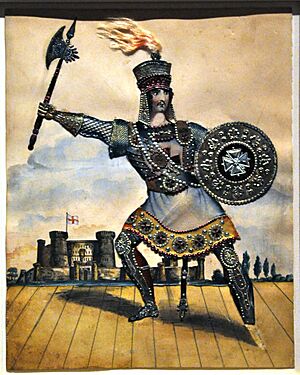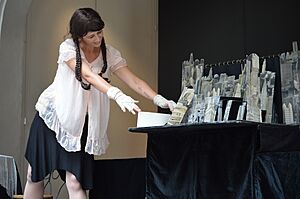Toy theater facts for kids
Toy theater, also known as paper theater or model theater, is a fun type of miniature stage that became popular in Europe in the early 1800s. These tiny theaters were often printed on strong paper sheets. People could buy them as kits at places like opera houses or playhouses. Families would take them home, put them together, and then perform plays for each other, sometimes even with live music!
Toy theater became less popular when real stages started focusing more on realistic stories in the late 1800s. Its popularity dropped again after World War II when television arrived. But guess what? Toy theater is making a comeback! Many puppeteers, writers, and filmmakers are enjoying it again. There are even international toy theater festivals happening all over the Americas and Europe.
Contents
The Story of Toy Theater
Early Days: 1800s Toy Theaters
The first toy theaters were like small copies of popular plays. They were sold as kits that people could build at home. These kits included everything: the stage, the scenery, the characters, and even their costumes! They were printed on paper and sold at English playhouses and libraries. You could buy them "a penny plain" (black and white) or "two pence coloured" (already colored).
Many people loved to color their stages by hand. They would even add shiny bits of cloth and tinsel to their characters. You could buy characters that were already decorated with tinsel, or buy supplies to do it yourself. Just like the toy stages were smaller, the play scripts for them were also shorter. They focused on the main characters and important lines to make the show quicker and easier to perform.
In the first half of the 1800s, more than 300 popular London plays were turned into toy theaters. Publishers would send artists to the theaters of Georgian and early-Victorian London. These artists would draw the scenery, costumes, and poses of the famous actors. Theater managers often gave these artists free seats because the toy theater sheets were great free advertising for their shows!
Changes Over Time: Late 1800s to Early 1900s
In the early 1800s, real stage plays were more about amazing sights than deep stories. This made them perfect for toy theater. But by the late 1800s, plays in Europe started to change. They became more about realism, focusing on how characters thought and felt. They also used more realistic sets. This new style of theater didn't work as well for toy theaters. So, toy theaters became less popular.
Even though it wasn't as popular, some famous artists still loved toy theater. In 1884, British writer Robert Louis Stevenson wrote an essay praising toy theater. He especially liked the plays from Pollock's. Other children's authors like Lewis Carroll and Hans Christian Andersen also enjoyed toy theater, as did Oscar Wilde. The brothers Jack and William Butler Yeats even used toy theaters to plan their art and stage designs.
In the 1900s, toy theater was used by artists who liked new and experimental ideas. People like futurist founder F.T. Marienetti and Pablo Picasso experimented with it. Film directors such as Ingmar Bergman and Orson Welles used toy theaters to plan their movies. Laurence Olivier even made a toy theater version of his film Hamlet, with a tiny paper cutout of himself! But after this short comeback, toy theater became less popular again. In the 1950s, television arrived, and people could watch stories and shows right in their living rooms without needing to operate a toy theater.
Modern Revival: Late 1900s to Today
Toy theater is now enjoying a new wave of popularity! Collectors and people who love old traditions perform classic Victorian plays. At the same time, creative puppeteers are trying new things. They adapt stories by famous authors or even tell stories about their friends, family, and neighbors.
Today's toy theater can use any kind of technology and cover any topic. There are many international toy theater festivals happening regularly in the Americas and Europe. These festivals attract well-known actors, musicians, and writers to perform on their tiny stages.
How Toy Theaters Are Made
Most toy theaters that are made in large numbers are sold as printed sheets. You can get them in black and white to color yourself, or already in full color. These sheets show the front of the stage (called the proscenium), the scenery, props, and characters.
You paste these sheets onto thin cardboard and then cut them out. After that, you put them together to act out a play. The character figures are often attached to small sticks, wires, or strings. This allows you to move them around the set. Some toy theaters even have moving parts and special effects! It's also common for performances to include live or pre-recorded sound effects and music.
Toy Theater in Movies and Books
- Adam Keen, who owned the Pollock Toy Shop, made a toy theater version of Laurence Olivier's 1948 film Hamlet. It came with characters and a short script.
- A toy theater appears near the end of the 1970 film The Railway Children.
- Author and artist Edward Gorey designed a toy theater based on his sets for the 1977 play Dracula.
- A toy theater is shown at the start of Ingmar Bergman's 1982 film Fanny and Alexander.
- The 1986 film version of The Nutcracker by Carroll Ballard and Maurice Sendak featured toy theater.
- Set designer Heidi Landesman based her designs for the 1991 musical The Secret Garden on toy theaters.
- Julie Taymor used toy theater puppets in a scene for the 2002 film Frida.
- Sean Meredith's funny 2007 film Dante's Inferno is entirely a toy theater film.
- Toy theaters are a common theme in many films by Jan Švankmajer.
- A toy theater is featured at the end of Terry Gilliam's 2009 film The Imaginarium of Doctor Parnassus. It's part of the story and also how the end credits are shown.
- In the 2011 video game Shadows of the Damned, players fight a demon on a screen that looks like a toy theater, with characters appearing as toy puppets.
- The 2019 Japanese film Violence Voyager uses a style that looks very much like toy theater.
Famous People Who Enjoyed Toy Theater
- Hans Christian Andersen, Danish author
- Jane Austen, British novelist
- Ingmar Bergman, Swedish film director
- Lewis Carroll, British author
- Charles Dickens, British novelist
- Ralph Fiennes, British actor
- Terry Gilliam, American film director
- Johann Wolfgang von Goethe, German author
- Edward Gorey, American author
- Ian McKellen, British actor
- Laurence Olivier, British actor
- Pablo Picasso, Spanish painter
- Robert Louis Stevenson, British author
- Jan Švankmajer, Czech filmmaker
- Orson Welles, American actor and director
- Oscar Wilde, British author
- William Butler Yeats, Irish poet
See also
- Puppetry
- Kamishibai
- Pollock's Toy Museum
- Benjamin Pollock's Toy Shop




